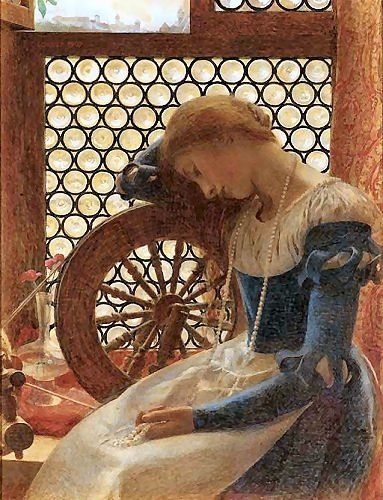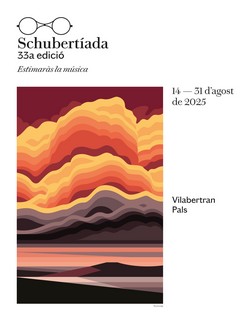In addition to the four posts published during the last few weeks, you will find in the series's page a 5th post, a kind of bonus track, the post by Ana Belén Ayala, who tells us about Mahler's Des Antonius von Padua Fischpredigt. Thank you very much, Christian and Ana Belén!

The poem consists of ten strophes of crossed rhyme, in which a scene of Goethe's Faust is represented. The scene depicts Margaret seated knitting in her spinning Wheel. Due to her fervent love, she is unable to find the peace and to get rid of the only thought that inevitably occupies her mind: her beloved. Her longing for him is such that she only wants to see him again, to have him and to kiss him; even if she ’’should die at his kisses!’’ The greatness of Goethe's poetry seems to have provoked a creative impulse in young Schubert. The varying strophic Lied form piece is written in D-minor as perfect abode for the sadness, the nostalgia and the dark afflicted occurrence of the plot.
In each stanza, the relationship between language and music is spontaneously restated. The piano, on the other hand, presents unique and avant-garde characteristics in its liederist function created by Schubert.
A rhythmic pattern of constant movement in a six-by-eight beat extends throughout the piece creating a perfect stage for the action. This rhythmic standard draws an automatically recognizable circular movement that represents the spinning wheel in which Margaret weaves without ceasing. The rhythmic movement is monotonous, although paradoxically moved and with incessant activity. Schubert achieves with this resource to transmit an important energy with absolute immediacy and intensity. The feeling of unity but also of transformation in the music that join this poem, drastically reveals the restless mood of the lovesick Margaret’s character.
At the beginning of the song, Schubert indicates "pianissimo, not too fast". The accompaniment of the piano, which does not add the voice until the end of the second measure, arises and develops itself following the pianissimo. It is characterized mainly by a rhythmic-melodic pattern that at the same time represents the spinning movement of the spinning wheel in which Margaret weaves without ceasing, and transmits the inner restlessness of our protagonist character. This melodic cell of agitated sixteenth notes runs and spreads throughout the song. It is quite obvious the association of a silent room in which the spinning wheel, turned by the anguished Margaret, emits a ceaseless buzzing eternally present in a quiet atmosphere of sounds but charged with agitated emotions.
The beginning of the voice in the second measure underscores the atmosphere of restlessness that the piano has sought.
The great contrast between the atmosphere of calmness and the effervescence of the resources of musical expression, highlights the tension experienced by the protagonist. These types of contrapositions are very characteristic in romantic music. As an undulating flow of emotions that come and go, the dynamic moves within the stanzas of pianissimos to fortissimos, and to pianissimos back...
From the 50th measure, coinciding with the sixth stanza of the poem, Margaret sighs recalling the physical aspect of Fausto expressing the attraction that she feels. The phrases of the singing line are now shorter and more and more separated from each other. From the sixth stanza, Schubert imposes a silence at the end of each verse. First eighth note silence, then quarter note silence, and later it will be the combination of eighth- and quarter note silences that separates each verse.
In the last verse of the seventh verse Und ach sein Kuß! (And, ah! his kiss!), experience both the music and the poem, their point of maximum tension. It is the culminating moment of the work. The previous silences that lead to this climax are the musical resource that emanates all the agitation required by this cusp of emotion; In this particular case, we speak about an excitement impregnated also with carnal desire. The section of the verse ach sein Kuß (oh, his kiss), is characterized not only by the presence of a great dramatic pause, but also is differentiated from the rest of the song through the harmony and rhythm that join it. Here, for the first time, the melodic-rhythmic piano accompaniment model, responsible for the movement of the spinning wheel, stops to become a contrasting chord of B-flat major that extends throughout measure 66. The constant and incessant flow of sixteenths exposed up to now in the whole piece, stops to give room for the stillness of a clad and prolonged in time chord. In this way, the bustle becomes immobility without warning.
Around the point where the words sein Kuß (his kiss) are acclaimed, certain harmonic changes occur that increase the tension of the passage, giving it an added drama. Both the diminished seventh chord and the G-note in the voice of the soprano, are prolonged throught a fermata. The brief interpretive silence immediately after the fading of the fermata is not noted in the score, but it is an indispensable pause for the attainment of the tension intended with the passage.
After this moment of silence, which symbolizes the end of the spin of the spinning wheel and the fear of Margaret of her own thoughts, gradually resurges the initial motive in the accompaniment of the piano. In bar 69 the piano is shown again in pianissimo dynamic and in bars 69 and 70 we can re-identify the motif of the spinning wheel, this time only in the second half of the bar. It is in measure 70, where the main melodic-rhythmic motif of the Lied, re-incorporates uninterruptedly oscillating between crescendo and decrescendo dynamics. Through the game that divides the characteristic spinning wheel’s motif and separates it by silence, Schubert draws with music in an absolutely exquisite way the timid resumption of the spinning motion of the spinning wheel at the hands of Margaret.
Immediately after this, the song adopts the calm character and the measured form of the beginning until the verses 9 and 10, in which Margaret returns to be anxious for a desired encounter with Fausto, confessing to longing for a kiss of him at any price. It is here that Schubert again interferes in the melody of the soprano by means of silences that interrupt the calm atmosphere, in order to transmit once more the exacerbated excitement of Margaret. After the singer's A high note in measure 111, the music is reassured again, gradually returning to the calm atmosphere of the beginning of the work.
The decrescendo in pianissimo and the ritardando of measure 113, are reinforced in the penultimate bar through a diminuendo on triple piano. In measure 120 we find the definitive cessation of this 'Leitmotiv' adopting a twin-track approach between the absurd mechanical movement of a spinning wheel and the extreme emotional turmoil of Margaret; through a last D-minor chord in triple p that extends throughout the bar. In the line of the soprano, we find in this same measure a silence with fermata.
The atmosphere of silence, from which emerges and begins this Lied, returns to manifest itself after two contrasts and varied resources of musical and literary expression, through the sound of a last silence that still prolongs in time.
Meine Ruh' ist hin,
Mein Herz ist schwer,
Ich finde sie nimmer
Und nimmermehr.
Wo ich ihn nicht hab
Ist mir das Grab,
Die ganze Welt
Ist mir vergällt.
Mein armer Kopf
Ist mir verrückt,
Mein armer Sinn
Ist mir zerstückt.
Nach ihm nur schau ich
Zum Fenster hinaus,
Nach ihm nur geh ich
Aus dem Haus.
Sein hoher Gang,
Sein' edle Gestalt,
Seine Mundes Lächeln,
Seiner Augen Gewalt,
Und seiner Rede
Zauberfluß,
Sein Händedruck,
Und ach, sein Kuß!
Mein Busen drängt sich
Nach ihm hin.
Ach dürft ich fassen
Und halten ihn,
Und küssen ihn,
So wie ich wollt,
An seinen Küssen
Vergehen sollt!
My peace is gone,
My heart is heavy,
I will find it never
and never more.
Where I do not have him,
That is the grave,
The whole world
Is bitter to me.
My poor head
Is crazy to me,
My poor mind
Is torn apart.
For him only, I look
Out the window
Only for him do I go
Out of the house.
His tall walk,
His noble figure,
His mouth's smile,
His eyes' power,
And his mouth's
Magic flow,
His handclasp,
and ah! his kiss!
My bosom urges itself
toward him.
Ah, might I grasp
And hold him!
And kiss him,
As I would wish,
At his kisses
I should die!
(translation by Javier Desilos)














Comments powered by CComment